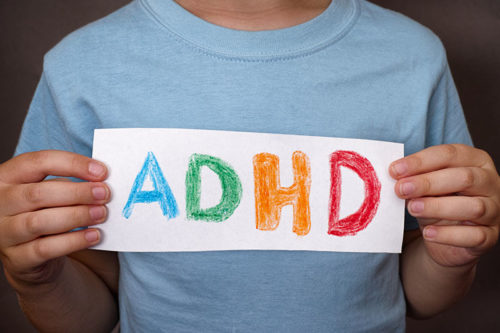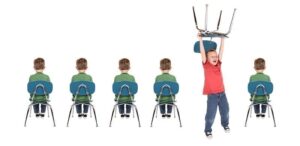Attention deficit hyperactivity disorder, Symptoms, and how to deal with it?

Educational institutions play one of the most prominent roles in shaping personalities and the basics of mental health for children from an early age. The school is the first community they encounter out of their home and familial comfort zone. Teachers are their parents in the outside world. From this stage, we exert the best efforts in our schools to understand and construct the proper educational pillars for children and create the appropriate environment for them. One of the most important aspects we consider is the mental health and disorders that children may go through. One of the most common disorders is Attention deficit hyperactivity disorder.

What is ADHD?
Attention deficit disorder is a childhood mental disorder that has a significant impact on a child’s behavior. In addition, it is difficult for children with ADHD disorder to deal with the surrounding community, their parents, their teachers, and even their classmates. Sometimes the children realize their problem, but can’t control their behaviors. In this case, it is a real obstacle for them to carry out their lives, activities, and achievements normally. Nearly half of students with ADHD never complete secondary school. Only 5% of them have university qualifications, compared to 28% of the general population. Three to five percent of school children suffer from ADHD disorder. It is also more prevalent in males than females.

Diagnosis of ADHD
ADHD is one of the developmental disorders when the development of certain personal behaviors such as impulse control is delayed. This is a three-to-five-year delay in growth. This delay is likely to lead to developmental impediments. Some criteria should be considered before the child is diagnosed with attention deficit hyperactivity disorder. Symptoms should appear before the age of 12. It must also last for at least six months. These symptoms should cause a real disability for children to carry out their lives and activities normally. İt’s important to monitor and determine if the symptoms are only related to a particular place. As it’s normal for some places to motivate the child’s activity, such as the play yard.

Symptoms of ADHD
Children with ADHD suffer from an impulsive state of hyperactivity, in addition to symptoms such as a poor focus on something for more than a minute. It is usually difficult to distinguish between normal levels of hyperactivity and mental dispersion and conditions that require medical intervention. Therefore, you should note that your child has been going through these symptoms for six months. To determine whether your child has ADHD. Keep in mind that the observation is in two different environments. Those symptoms must be more severe than those of other children of the same age.
Attention deficit hyperactivity disorder (ADHD) is divided according to its symptoms into three categories: the first group is predominantly distracted. The second category is dominated by excessive motor activity and impulsivity. The third category is a combination of the previous two categories in which distraction, motor activity, and impulsiveness are all together. Each category has its own symptoms
The first type suffers from:
- Distraction
- Attention deficit to details, and frequent forgetting.
- Frequent hesitation between different activities
- Getting bored of performing one activity shortly especially if it’s not fun.
- Attention deficit and barely focus on any work or learning something new
- Having trouble completing activities and duties
- Loss of personal stuff most of the times
- Spending a long time daydreaming, accompanied with easy confusion and slow movement
- Having trouble processing information with a good level of speed and accuracy compared to those of the same age
- Also, it is difficult for a child with ADHD to follow instructions
The composite type is the group distinguished with two major problems, hyperactivity, and impulsivity in which the child suffers from:
- Anxiety and restlessness when sitting in a fixed place
- Constant tendency to talk.
- Excessive movement everywhere and touching whatever they see.
- Having trouble stilling during activities such as eating, studying, or getting ready to sleep
- Having trouble performing tasks or activities quietly.
Some symptoms refer to impulsivity as an essential characteristic and include:
- Inability to be patient
- Acting without taking the consequences into account
- Expressing feelings without restraint
- It’s hard for them to wait for the things they want.
Symptoms of ADHD may last from children until adulthood.

Factors causing attention deficit hyperactivity disorder
Genetic factors
Researchers believe that the factors causing attention deficit hyperactivity disorder are stemmed from genetic traits. Some researches have shown that there have been pivotal changes in brain formation and performance in children with the disorder. In addition, a lower level of activity has been observed in the cerebral areas responsible for activity and attention. The disorder is also genetically transmitted from generation to generation, with research showing that one in every 40 children with the disorder has at least one relative who suffers from the same disorder.
Environmental factors
There are some environmental factors that affect the child’s behavior and increase the chance of ADHD disorder. For example, Smoking during pregnancy, excessive use of addictive substances, can affect brain cells. Exposure to toxic environmental pollutants during pregnancy also has the same effect in contributing to the risk of infection.

Behavior Modification Treatment for Children with ADHD
Behavior modification aims to deal with the situation of each child and to improve and control each child’s behaviors. To reach out to the normal patterns of positive behaviors and modify unwanted negative behaviors. This can be achieved in several steps.
- Avoid reprimand and heavy criticism in all cases
- Praise the positive things that the children achieve, in order to enhance their self-confidence and support their will to change and correct their negative behaviors
- Set a reward agreement that would be applied whenever the children achieve any positive behavior.
- Praise and encourage positive behavior, even with a simple compliment like “excellent” and “well done.”
- Parents must represent and clarify meaningful behavior in order for the child to follow the example and see through the parents an effective and realistic model of that.
- Providing material or moral rewards for positive behavior of the child. Keep in mind that the reward should be for achieving tasks or positive behaviors not just for obedience.
- Setting reward points for positive behaviors and tasks to be achieved by the child. Once completed, he gets the parallel points. With a good number of points, these points are redeemed with rewards that are predetermined in agreement with the child. It is important for children to know that they may lose one of those points in case of violating one of their duties.
One of the most important steps of behavioral modification for children with ADHD is the development of self-control. One of the most effective ways to achieve this is by speaking to oneself. The children learn to face their behavior by talking to themselves. For example, in a particular situation, they ask themselves what to do. To warn themselves if they are about to fail in something. It is important for parents to remind the children to say to themselves: “Stand up and think.” Or a few simple sentences that would help them to interact well with everyday situations in the best way, such as: “Calm down”.
It’s also important to give the children the opportunity to talk about their problems. To help them to try as much as they can to carry out the required instructions, the children must be aware that it is for their own benefit in the first place. İt’s important for the children to learn how to record the problems they encounter in a short period of time. This is to help them focus and learn the concept of self-control rather than adult control.

Treatment of ADHD
Treatments for ADHD include drug treatment, as well as consultation and follow-up with a psychiatrist. There are also some treatments that help relieve symptoms, including:
- Organizing and defining a child’s space within the classroom
- Family and environmental support
- Pharmacological drugs that activate the brain and balance the ratios of chemicals in the brain are known as neurotransmitters between nerves.
- Drug therapy contributes to alleviating symptoms. However, it must go hand in hand with follow-up, psychological counseling, and cooperation from the surrounding environment to deal with the children appropriately according to their condition and to support them towards effective recovery.
In this regard, our role in “Rowad Alkhaleej international schools – Al-Malka branch in Riyadh“, as a specialized educational institution equipped with the latest methods and curricula to deal with children with ADHD and attention disorders, is to provide all services for children with special needs where a group of Specialists and consultants are ready to deal optimally with children and facilitate their educational process. In addition to efficient supervision and specialized behavior modification methods for children with ADHD. We are keen on making our curriculum well developed and adapted to the requirements of children with special needs and ADHD disorder. Hopefully, we help pave the way for them to live a life full of success and great achievements.
